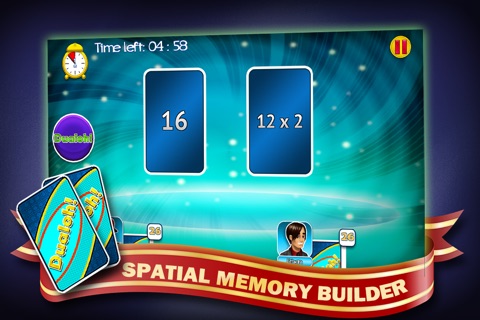
Dualoh app for iPhone and iPad
Developer: Mobile App City Pty Ltd
First release : 28 Jun 2014
App size: 123.46 Mb
An infectious card game that improves mental thinking and makes the brain work.
DUALOH develops a player’s mental thinking because players are quickly calculating in their heads. It is brain training activity because a player needs to adjust to the changing mathematical representations shown on the cards. These mathematics representations are shown in pictures, words or numbers and players are switching from one representation to another. Players are involved in logical thinking. There are four different games in this app that make players think before they make a decisions about which card represents the highest value. Players have to make decisions in time sensitive mathematical card activities. A feature of the app is that there are 3 different levels and three different times that the card games can be completed.
In playing the game the players are challenged and are continually making quick decisions about the highest card. Sometimes these decisions are estimations. Players are required to react to the change in mathematical representation shown on the actual cards and select the mathematics response from their mental and mathematical understanding. The DUALOH cards give the players the opportunity to practice essential mathematics.
Features:
-Leader board
-Leagues – novice smart and genius (10,5 and 3 seconds to answer. Higher league gives more scores)
-Play for 2, 3 or 5 minutes per gamer
4 Different Games:
Counting game
The mathematics ideas in this game focus on numbers from 1-12 and include abstracted numbers such 9, 7, 12 etc. These numbers are also shown as dot arrangements which the player can use their subitising , counting or partitioning skills The players will develop flexible ways of dealing with early number , increase their capacity to improve their response time and as an outcome improve their ability to see mathematics in a different way
Whole Numbers Game
The mathematics ideas in this game focus on the numbers 10-110 and include abstracted numbers such as 92, 50, 45 etc. The numbers 10-110 are also shown as additions 45+10, written as their actual number in word form, as less than or more than. So the number 55 could come up as; fifty five, 5 less than sixty, 5 more than 50, 40+15, or as the symbol 55. So a player, not only have to recognise the abstracted number but they also have to recognise the alternative ways that the number can be shown. This game improves the players whole number knowledge, their understanding of alternative forms of a given whole and their mental and thinking skills.
Times
The Times game focuses on 2, 3, 4, 5 times table. These times tables are suitable for children of 9/10 years of age and anyone that needs improve their basic multiplication tables. Included in these games are the products of tables. For example 24 could be 2x12, 12x2, 3x8, 8x3, 4x6 and 6x4. Notice that the commutative property for some of the tables is important aspects of this game. This game improves students speed and accuracy. It also develops their ability to be flexible by recognising the link between the products and the commutative property of the factors of those products.
Fractions
The cards have the written fraction, picture fractions in circles and grids and equivalent fractions of ½, 1/3 etc. For example a half is shown as ½, 3/6, 5/10 or half a circle or half a grid of ten squares. This game allows players to move between written fractions and pictures of fractions. It becomes difficult recognising the picture forms of the multiples of the above fractions. This game improves players’ fraction fluency and their visual perception. The metacognitive thinking needed in this game supports the development of a flexible mathematical mind.



